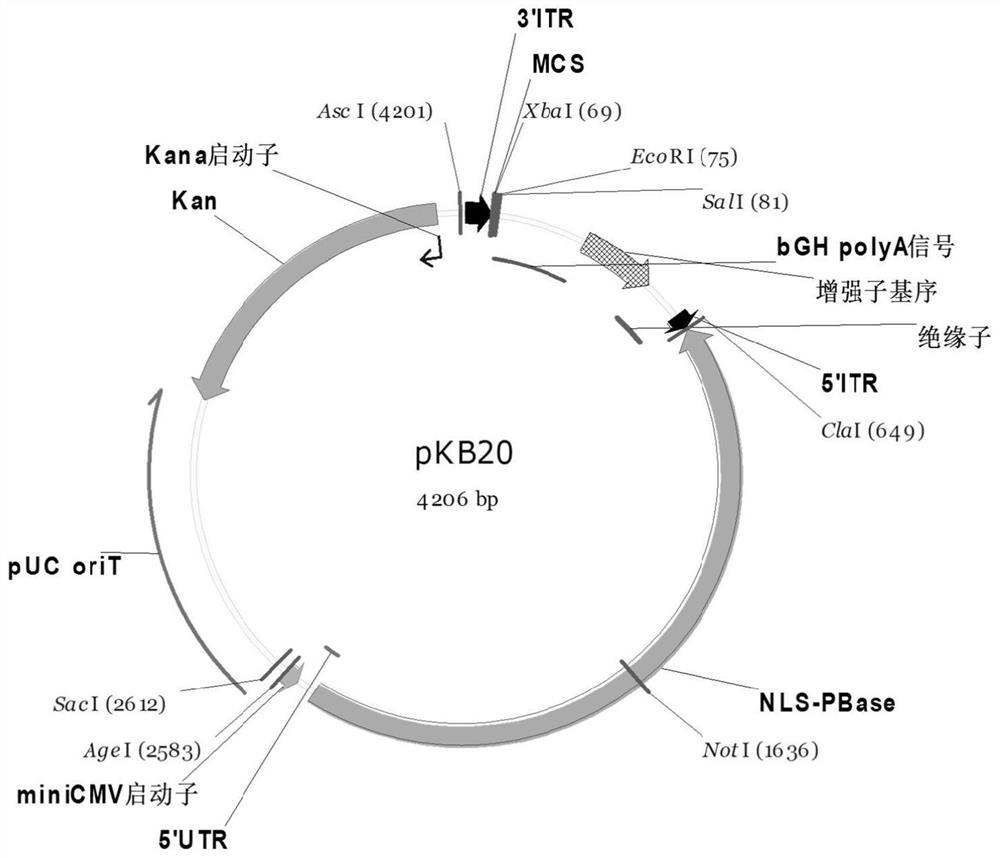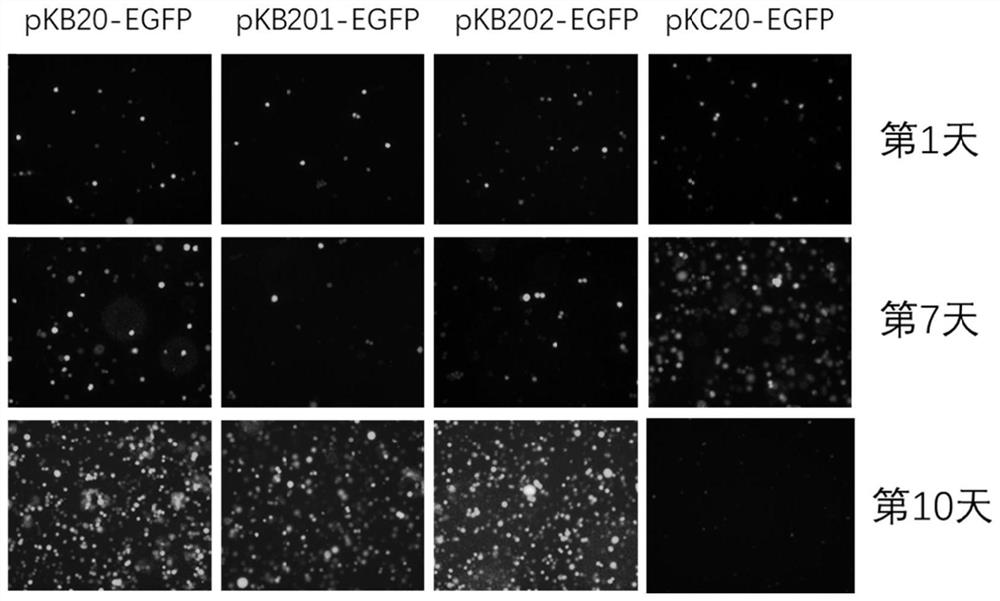Novel PiggyBac transposition subsystem and application thereof
A technology of transposon and transposase, which is applied in the direction of introducing foreign genetic material by using vectors, cells modified by introducing foreign genetic material, gene therapy, etc. It can solve the problems of low efficiency, high toxicity of plasmid DNA, and expanding the amount of electroporation And other issues
- Summary
- Abstract
- Description
- Claims
- Application Information
AI Technical Summary
Problems solved by technology
Method used
Image
Examples
Embodiment 1
[0130] Embodiment 1, the construction of carrier
[0131] pKB20: PiggyBac transposon 3' terminal repeat sequence (3'ITR) (SEQ ID NO: 1), multiple cloning site (SEQ ID NO: 2), bGH polyA signal sequence (SEQ ID NO: 3) in sequence ), enhancer motif sequence (SEQ IDNO:4), insulator sequence with transcription termination function (C2 transcription pause site, SEQ ID NO:5), PiggyBac transposon 5' terminal repeat sequence (5'ITR) ( The reverse complement of SEQ ID NO:6), the reverse complement of the PiggyBac transposase coding sequence (SEQ ID NO:7), the reverse complement of the 5'UTR sequence (SEQ ID NO:8), and the miniCMV promoter The reverse complementary sequence of the sequence (SEQ ID NO:9) was spliced into a long sequence (SEQ ID NO:10), which was synthesized by Shanghai Jierui Biotechnology Co., Ltd., and AgeI and AscI restriction sites were added at both ends , loaded into pUC57 (purchased from Shanghai Jierui Biology), named pKB20. For a schematic diagram of the pl...
Embodiment 2
[0162] Example 2, the integration of pKB vector containing EGFP expression cassette in Jurkat cells
[0163] Prepare 5×10 6 Vigorously growing low-passage Jurkat cells were transfected with 5 μg of pKB20-EGFP, pKB201-EGFP, pKB202-EGFP, and pKC20-EGFP into the nucleus (according to the instrument operating instructions) through the Lonza2b-Nucleofector instrument. 37°C, 5% CO 2 Incubator culture. After the cells were confluent, they were subcultured at a ratio of 1:10. On the 7th day, the 10th day, and the 14th day after the electroporation, the fluorescence microscope photographed and observed; the 7th day, the 10th day, and the 14th day (after 3 passages) after the electroporation were used to detect the change in the proportion of EGFP-positive cells, Jurkat cells not transfected with the plasmid were used as a control for flow cytometry. Cell fluorescence intensity was observed by fluorescence microscope during the whole process of electroporation. Viable cell counts...
Embodiment 3
[0169] Example 3, PB transposase expression time curve after pKB vector electroporation into Jurkat cells
[0170] Take 5×10 6 Vigorously growing low-passage Jurkat cells were transfected into the nucleus with 5 μg of pKB20-EGFP, pKB201-EGFP and pKB202-EGFP (according to the instrument’s operating instructions) using the Lonza2b-Nucleofector instrument, 37°C, 5% CO 2 After culture, cells were collected at 6, 12, 24, 48, 96 hours and 15 days after electroporation, and RNA was extracted, and the expression level of PB transposase was quantitatively detected by RT-PCR using β-actin as an internal reference. The results were as follows Figure 5 shown.
[0171] Figure 5 It was shown that the expression level of PB transposase in Jurkat cells electroporated with pKB20-EGFP, pKB201-EGFP and pKB202-EGFP reached the peak at 6h, and then began to decrease significantly. The expression level of PB transposase in the electrotransfected pKB20-EGFP and pKB201-EGFP cells was signific...
PUM
 Login to View More
Login to View More Abstract
Description
Claims
Application Information
 Login to View More
Login to View More - Generate Ideas
- Intellectual Property
- Life Sciences
- Materials
- Tech Scout
- Unparalleled Data Quality
- Higher Quality Content
- 60% Fewer Hallucinations
Browse by: Latest US Patents, China's latest patents, Technical Efficacy Thesaurus, Application Domain, Technology Topic, Popular Technical Reports.
© 2025 PatSnap. All rights reserved.Legal|Privacy policy|Modern Slavery Act Transparency Statement|Sitemap|About US| Contact US: help@patsnap.com



